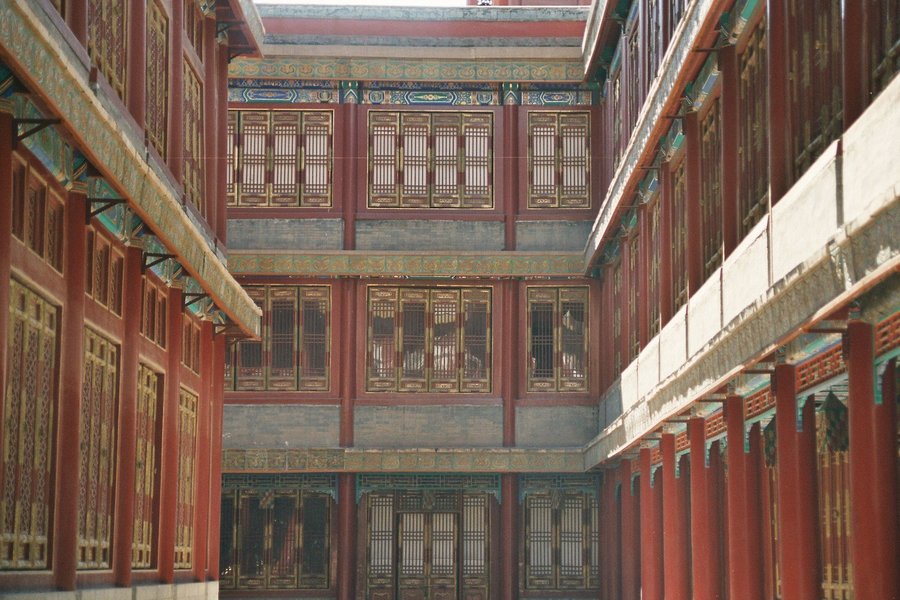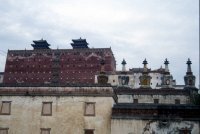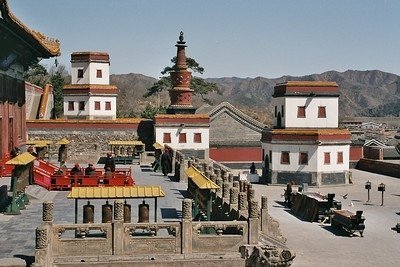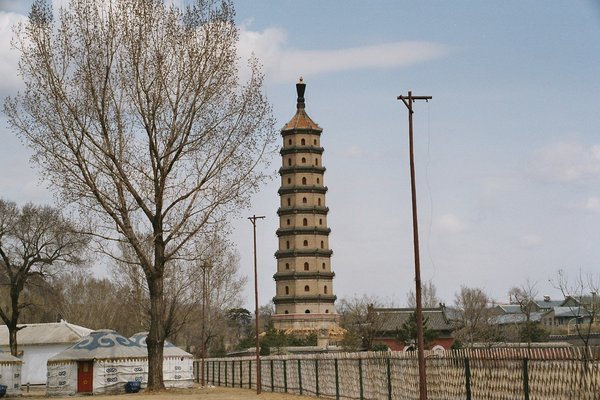China
Mountain Resort, Chengde
The Mountain Resort and its Outlying Temples, Chengde, comprise a designed landscape that served as the summer resort of the Qing emperors.
At the end of the 17th century, the Qing emperors created a summer residence, exploiting mountains, woods and other existing natural features to which they added contrived landscapes to make settings for innumerable pavilions, palaces and temples. Some temples outside the palace walls were built in the architectural styles of the ethnic minorities, affirming China as a unitary multi-ethnic state.
Community Perspective: The site consists of extensive gardens and outlying temples, and needs at least a full day. Don’t come here in winter! It’s a controversial site as well, as detailed by Solivagant.
Site Info
Official Information
- Full Name
- Mountain Resort and its Outlying Temples, Chengde (ID: 703)
- Country
- China
- Status
-
Inscribed 1994
Site history
History of Mountain Resort, Chengde
- 1994: Inscribed
- Inscribed
- Type
- Cultural
- Criteria
- ii
- iv
Links
- UNESCO
- whc.unesco.org
- Official
-
- travelchinaguide.com — China Travel Service entry showing times,cost, best months etc
- Related
-
- en.wikipedia.org — Link
All Links
UNESCO.org
- whc.unesco.org — whc.unesco.org/
Official Website
- travelchinaguide.com — China Travel Service entry showing times,cost, best months etc
Related Resources
- en.wikipedia.org — Link
News Article
- Dec. 6, 2019 xinhuanet.com — Dinosaur footprints found in ancient Chinese imperial resort
- Aug. 2, 2018 ecns.cn — Dinosaur footprints found in stone slabs at Chengde’s UNESCO heritage site
- June 13, 2016 ecns.cn — Restoration on major buildings in Putuo Zongsheng Temple in Chengde completed
- March 1, 2013 globaltimes.cn — Fire at Putuo Zongcheng Temple
- June 6, 2011 china.globaltimes.cn — Luxury private club built in Chengde Mountain Resort
Community Information
- Community Category
- Secular structure: Park or garden
Travel Information
Beijing hotspot
Recent Connections
-
Copy of WHS
Potala Palace, Suzhou Gardens
-
Perfect Inscriptions
1994 -
In Video Games
Civilization VII
Connections of Mountain Resort, Chengde
- Individual People
-
-
Lord George Macartney
Sun 8 - Sat 21 Sept 1793. Visits the Palace (meets the Emperor and does not kowtow), Western Garden, Putuo Zongcheng Temple ( or "Potala")
-
- Trivia
-
-
Copy of WHS
Potala Palace, Suzhou Gardens
-
In Video Games
Civilization VII -
Modelled after
Contains a full size copy of the Potala Palace
-
- History
-
-
Eunuchs
-
Summer residences
-
Anglo Chinese Relations
Visited in 1793 by Lord Macartney, the first British Envoy to China, in an attempt to meet the Emperor Qianlong and conclude a trade agreement. Famously Macartney refused to kowtow in front of the emperor (unlike his Dutch equivalent Isaac Titsingh in 1795!). No agreement was reached and in a polite letter to George III the Emperor stated that "we possess all things. I set no value on objects strange or ingenious, and have no use for your country's manufactures." -
Feudalism
The site represents in material form, moreover, the final flowering of feudal society in China (AB ev)
-
- Architecture
-
-
Gold Surfaces
Putuozongsheng Temple's golden roof -
Designed by Lei family
-
Chinese Garden
one of four Chinese great gardens -
Octagons
Sarira 9 story pagoda -
Conical roofs
Pule Temple, one of eight temples -
Wooden architecture
-
- World Heritage Process
-
-
Perfect Inscriptions
1994
-
- Religion and Belief
-
-
Stupa
-
Pagoda
A 70 m tall stone Chinese pagoda, one of the tallest in China, built in the year 1751 during the reign of the Qianlong Emperor -
Tibetan Buddhism
See page 8 of link: "the revival of Tibetan Buddhism in the frontier brought an isolated lama organization, which cannot express the feudal structure in the minzu area, the red cowl of the lamas and the sound of reading classics from the temple were only some sad symbol of the history."
-
- Human Activity
-
-
Hunting Lodge or Castle
"used to be a summer resort and hunting ground for emperors of the Qing Dynasty (1644-1911)"
-
- Constructions
-
-
Theatres and Opera Houses
"Pavilion of Clear Sound" (Qingyinge) -
Giant Buddha statues
The Puning Temple houses the world's tallest wooden sculpture of the Bodhisattva Avalokitesvara (22.28-meter-high and 110-ton) (wiki) -
Suspended cable cars
To Sledgehammer Peak
-
- WHS on Other Lists
-
-
World Monuments Watch (past)
Puning Temple Statues (2004)
-
- Timeline
-
-
Built in the 18th century
Built between 1703 and 1792
-
- WHS Hotspots
-
-
Beijing hotspot
Trains from Beijing East Railway Station to Chengde South is just 1h and frequent. From Chengde South Railway, you can take a bus to the scenic area.
-
News
- xinhuanet.com 12/06/2019
- Dinosaur footprints found in ancie…
- ecns.cn 08/02/2018
- Dinosaur footprints found in stone…
- ecns.cn 06/13/2016
- Restoration on major buildings in …
Recent Visitors
Visitors of Mountain Resort, Chengde
- Alexander Lehmann
- Alex Goh
- Ansitong
- Artur Anuszewski
- Atila Ege
- AustralLights
- Bamse
- Bernard Joseph Esposo Guerrero
- Bin
- Boj
- Chalamphol Therakul
- chenboada
- Christravelblog
- Dimitar Krastev
- Dolemite92
- Dr. Caligari
- Dwight Zehuan Xiao
- Elisabeth Fransisca Situmorang
- Els Slots
- Erik Jelinek
- Fan Yibo
- GeorgeIng61
- Helios
- henryjiao18
- Iain Jackson
- Jarek Pokrzywnicki
- Jeffrey Chai
- Joyce van Soest
- jxrocky
- Karito Vies
- Kasper
- Knut
- Kristin
- lichia
- Ludvan
- Luke LOU
- Maciej Gil
- MaYumin
- Michael Turtle
- Miloš Tašković
- nan
- Patrik
- Paul Schofield
- Pchxiao
- Philipp Peterer
- Pieter Dijkshoorn
- Pink Bunny
- Remski
- Risson
- Rubbie
- Sergio Arjona
- Shijie ZHU
- SnakeGreen
- Solivagant
- Ssong.x
- Taotao Chen
- Thomas van der Walt
- trekkie900
- Vincent Cheung
- wantrain.
- Weecheng
- Xiquinho Silva
- Yang Chengyu
- Yongcheng Liu
- Zhenjun Liu
- Zhou Yan
- Zoë Sheng
- Zos M
- ZZSong
Community Reviews
Show full reviews
This being a summer resort, should not be visited in the winter,like I did. Much of it was closed, and the alleged scenic beauty was not apparent. Do spend a little time to learn the history, and study the seven different schools of Buddasm ( Tibetan, Mongolian, etc.) that resulted in seven different temples built by the Qing emperor to unite the people, including a replica of Tibetan Patala Palace
Keep reading 0 comments
I went to Chengde on a survey trip for an update of my film on China for Disney's EPCOT Center. I wasn't able to film there for the original film ("Wonders of China") and we simply didn't have enough room to fit it into the updated film either, but that doesn't mean the locale isn't spectacular. I ran into an old man in the park who was a retired school teacher and he volunteered to be my guide. He was a wonderful source of local information and could not have been more open and friendly. I've exchanged a number of letters with him since then and hope to look him up when I return to Chengde in the autumn of 2006 for a new filming assignment.
Keep reading 0 comments
Apparently the original Qing name for this site meant “The Mountain Resort for Escaping Summer Heat”. You too might find it a pleasant escape from Beijing – it is only a few hours away by bus or train. Its main part consists of pavilions, temples, gardens, streams and lakes not that different (albeit writ very large!) from what you might have seen at the Old and New Summer palaces in Beijing – but attractive enough. It was constructed across the 18th century and consisted of 2 parts divided apparently by a “mini Great Wall” – inside were copies of 72 Chinese beauty spots and temples and a “Garden of 10000 trees”. Outside the wall (the "Outlying Temples" of the modern title) were 12 Tibetan Buddhist temples - 8 of which remain (photo). These included “reproductions” (more or less) of the Dalai Lama’s residence, the Potala and the Panchen Lama’s residence at Shigatse.
However, as you wander around, you might not be aware either of the original “Political” purpose for the creation of the site nor for the possible “political” ramifications of its current restoration and elevation to UNESCO inscribed status. Was it entirely coincidental that the Potala in Lhasa was inscribed in the same year (1994)as this site? Has UNESCO allowed itself to become a pawn in China’s nationalistic policy of fully incorporating Tibet within the borders of the PRC? Indeed can “Inscription” ever be purely a “neutral” or rather a "Universal" rather than a "Nationalistic" political and cultural act?
…
Keep reading 0 comments
I spent two full days in this city, four hours north of Beijing by bus. Chengde itself is a nice enough encounter with Chinese city life outside the capital. No Mcdonald's or Starbucks can be found here. What it does have is steam trains - an internet search in preparation for this trip resulted in many exciting stories by trainspotters.
But I had my own spotting to do: the Chengde Imperial Resort as World Cultural Heritage. On my first day, I explored the huge park. Don't be fooled by the somewhat standard Chinese gates and buildings at the entrance: when you've passed them you enter a lovely landscape park. There are several lakes, a steppe, and a forest. In the best "natural" spots, pavilions and temples were added. For example the tall and elegant Yongyou si Pagoda.
The next day I walked to some of the outlying temples. Most prominent is the Putuozongsheng, modelled after Lhasa's Potala Palace. It's a strange sight to see it here, in northern China, as well as in the neighbouring Xumifushoumiao (a recreation of the Tashilhunpo monastery in Xigaze). Both are well looked after and brightly painted, but lack the atmosphere of an active Buddhist monastery.
Keep reading 0 comments
